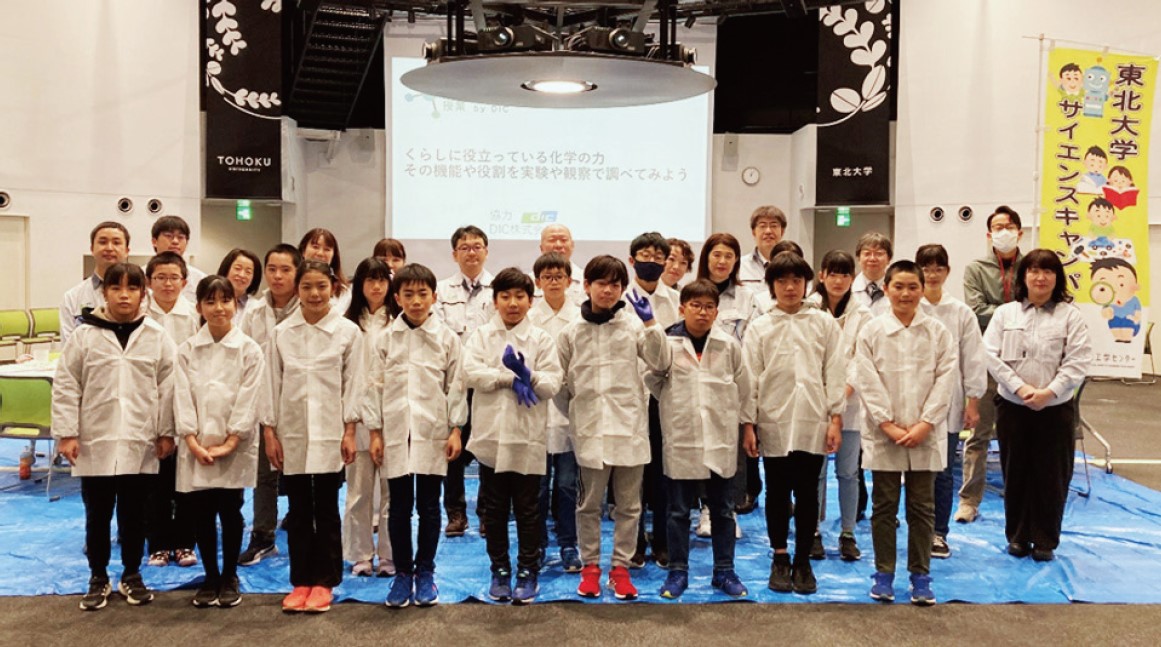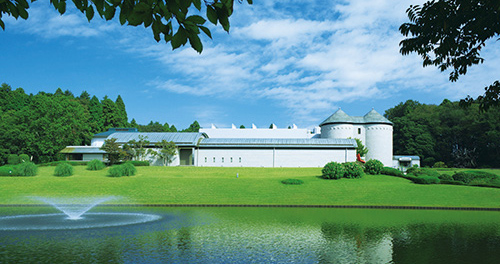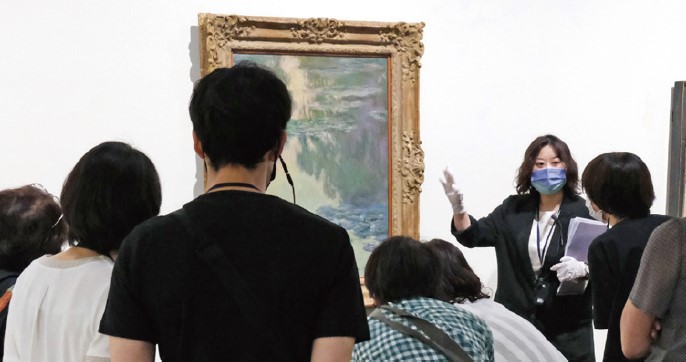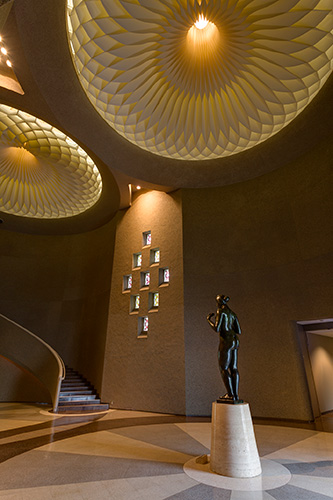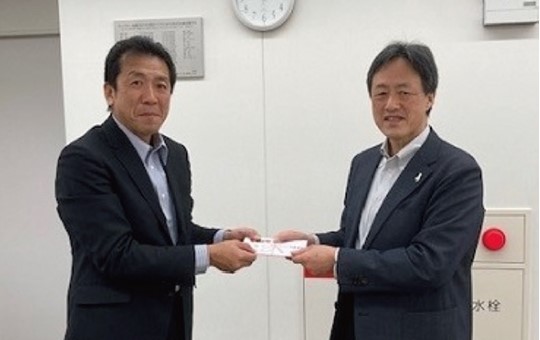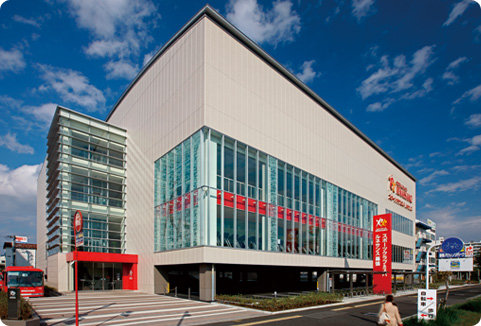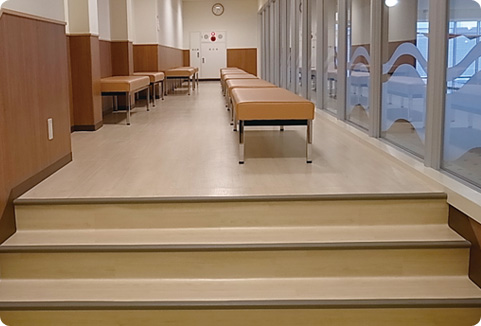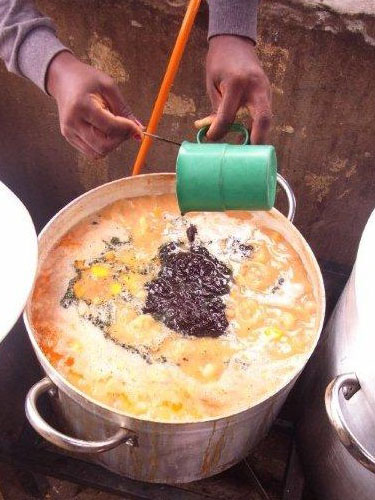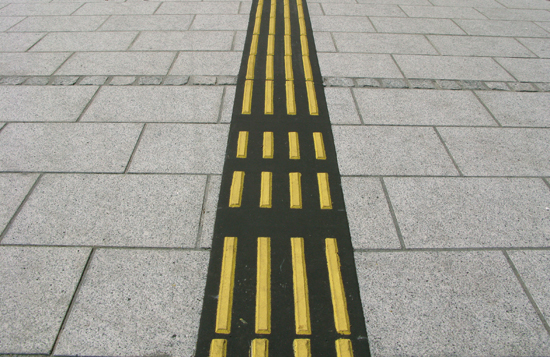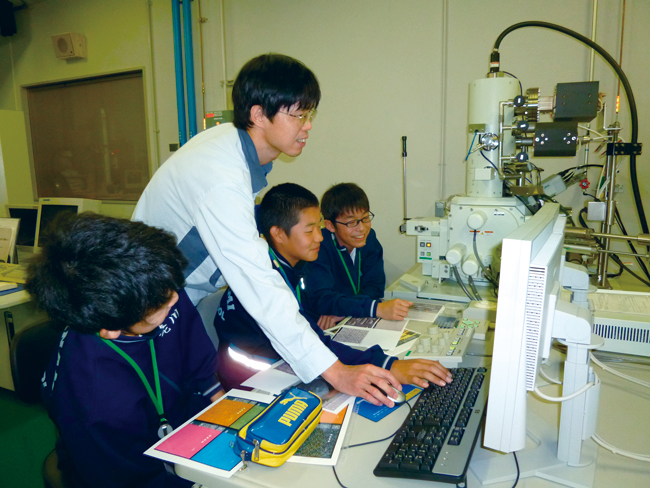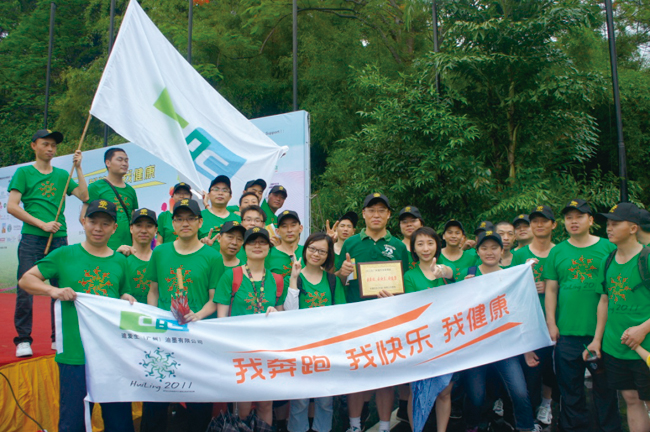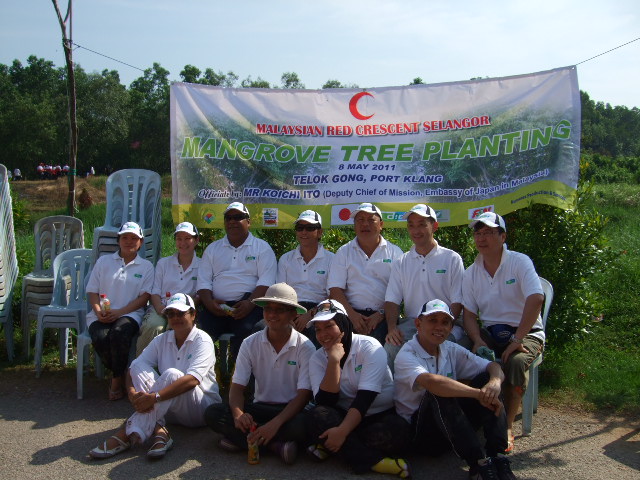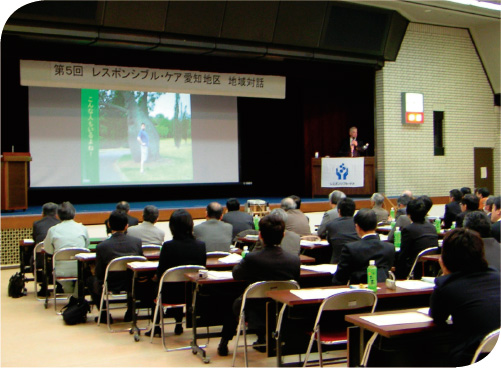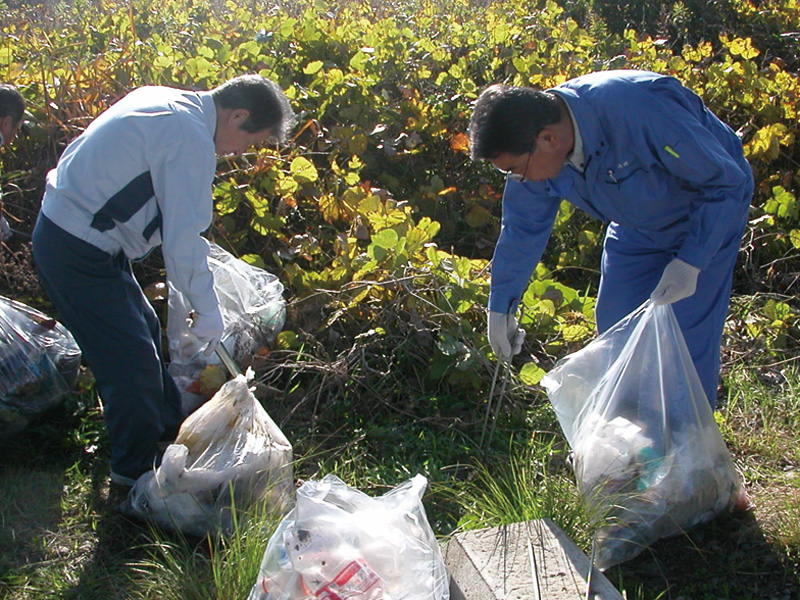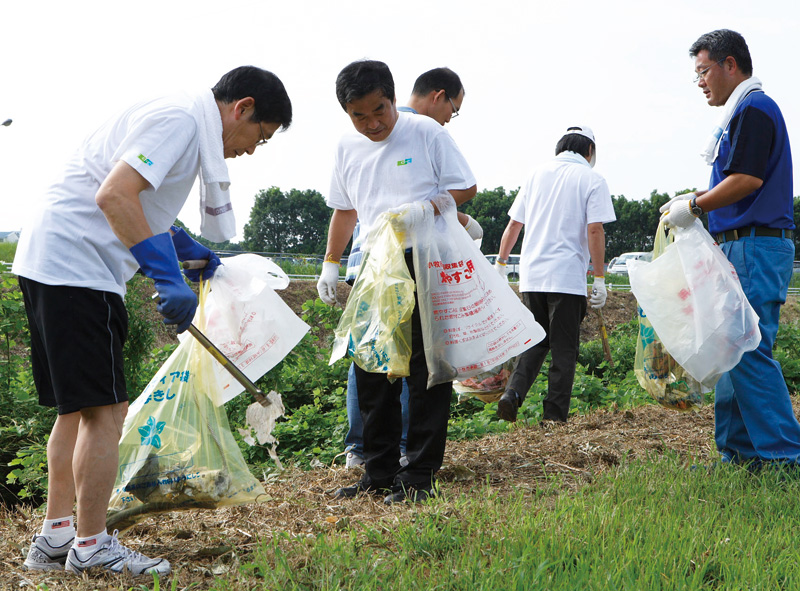Harmony with the Community and Social Contributions (Special topics before 2023)
- CUD: The Future of Color and Comfort
- Visiting Science Lab Program
- Initiatives Led by the Central Research Laboratories
- Initiatives Led by the Kashima Plant
- Kawamura Memorial DIC Museum of Art
- Initiatives at DIC Group Companies in Other Countries and Territories
- Matching Gift Program
- Contributing to Efforts to Address COVID-19
- Capitalizing on Business Opportunities Yielded by Recycling Initiatives
- Highlights of Social Contribution Activities
Color Universal Design in interiors and signs in a sports club - Spirulina: Promoting Harmony With Society
- Highlights of Social Contribution Activities
Initiatives Toward Color Coordination that is Harmonious with Landscape - Career Education Activities
- Proactively Supporting the Next Generation Development from Working Experience for Junior High School Students to Training Cooperation for Teachers
- Support for Persons with Intellectual Handicaps
- Support for Disaster-Hit Areas
- Mangrove Plantation Project
- Initiatives Aimed at Areas around Our Plants
- Regional Clean-Up Activities and Others
Principal Initiatives
CUD: The Future of Color and Comfort
Guided by its vision statement, the DIC Group is actively involved in R&D in the area of color universal design (CUD), helping to bring color to life through efforts in a variety of fields.
・Initiatives in Fiscal Year 2023
DIC began providing the brand logo and user manual for Lucida® tactile paving blocks—which combine high visibility for visually impaired individuals and is in harmony with the environment—free of charge to tactile paving manufacturers. This allows the use of Lucida® blocks together with blocks sold by other manufacturers made from different materials, including ceramic tile, resin and concrete, by ensuring the same color. In addition to ensuring the visibility and recognizability of tactile paving, this helps secure aesthetic coherence for areas where this paving is installed.
The Lucida® logo was developed by DIC Group company DIC Color Design, Inc. The tail on the “u” evokes the enhanced walkability made possible by tactile paving. Going forward, DIC will continue working to advance the creation of social infrastructure that incorporates CUD.
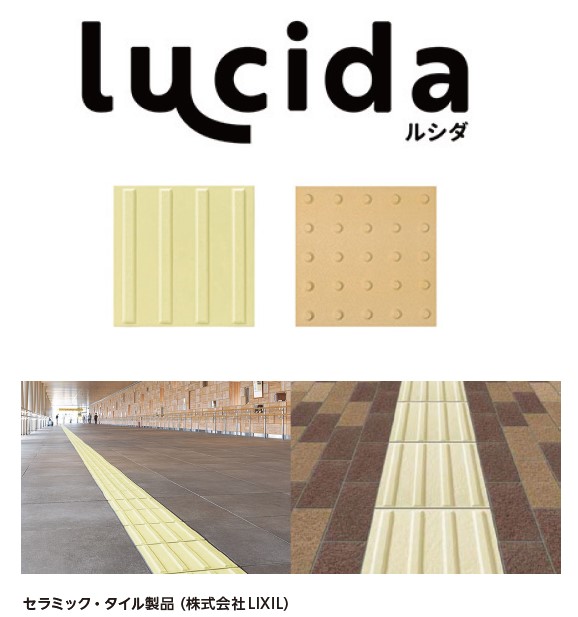
• 2007–2010
Under the supervision of the University of Tokyo, the DIC Group worked with the Japan Paint Manufacturers Association, the Industrial Research Institute of Ishikawa and the Color Universal Design Organization, an NPO, to create the Color Universal Design–Recommended Color Set.
• 2011–2014
The DIC Group and architect Kengo Kuma collaborated to develop new tactile pavement that ensures high visibility for visually impaired individuals and is in harmony with the landscape. Subsequently, in spring 2018, two new colors—a warm orangey yellow and a cool yellowish green—were commercialized under the name Lucida®.
• 2015–2017
The DIC Group participated in a joint industry–academic research project, as part of which Chiba University, the Central Research Laboratories and DIC Color Design gave presentations at academic conferences around the world on research regarding the color appearance of red spot colors used for printed warnings and other information on packaging and on the use of color in printed materials to enhance readability for seniors.
• 2018
Taking into account nearly a decade in use, the Color Universal Design–Recommended Color Set’s color values were revised and a guidebook was published to further enhance the set’s usability. In addition, the Japan Industrial Standards (JIS) announced new safety colors that can be distinguished by people with diverse types of color vision (JIS Z 9103). As a member of the original drafting committee, the DIC Group was involved in setting recommended CMYK values for process printing and collaborated in subsequent activities aimed at advancing awareness.
• 2019–2021
The DIC Group collaborated in the verification of color schemes for disaster applications including prevention-related information. This included taking part in verification testing for screen displays for a color scheme (five colors) developed to convey heavy rain warning levels in an easy-tounderstand manner, which was announced in 2020 by Japan’s Cabinet Office. In formulating CMYK values for this color scheme, announced in 2021, DIC Graphics cooperated by not only verifying candidate colors but also printing a color chart for use in the verification process.
• 2022
The DIC Group published a feature article on its efforts to contribute to society through the provision of color in the Japanese-language space of its global website. Since then, the Group has worked to provide stakeholders with information on its initiatives to make society more accessible to people with diverse types of color vision, as well as to introduce key difference makers from both within and outside the Group.
Visiting Science Lab Program
In line with the Japanese government’s efforts to further career education initiatives, DIC conducts visiting science labs at public elementary schools. Since the launch of this program in 2010, DIC has provided labs for approximately 3,350 students at 47 facilities (elementary schools and university facilities, the latter as part of an event).
In fiscal year 2023, the Company participated in Tohoku University’s Science Campus project with a lab for 38 participants, primarily fifth- and sixth-year students. Based on the theme of “Color & Comfort,” the lab highlighted how science can help secure a brighter future for humanity and the planet, and comprised experiments that involved observing the mechanism of color printing, extracting natural pigments from algae and dissolving recyclable adhesives. The program was well received by participating students, who commented on the interesting nature of the experiments and the joy of making new discoveries, and studiously took notes. Going forward, the DIC Group will continue to promote this and other “Color & Comfort”-themed programs that make science fun for children and which spark enthusiasm for chemistry.
Initiatives Led by the Central Research Laboratories
The Central Research Laboratories provides support for education through a variety of initiatives. These include assisting with the Annual Meeting on Scientific Research by High Schools, which is sponsored by Chiba University’s Section of Collaboration with High Schools.
The Central Research Laboratories also advances efforts that leverage DIC’s unique capabilities. These include lectures for high schools that have earned Super Science High School* designation, including Seishin Gakuen High School in Ibaraki Prefecture, and Sakura Senior High School and Funabashi High School in Chiba Prefecture, as well as fashion design workshops for students from Sakura Higashi High School in Chiba Prefecture.
In addition, in an initiative aimed at assisting with regional revitalization efforts, the Central Research Laboratories has cooperated with the Sakura Film Commission since 2022 at the request of the Sakura City government. This includes allowing use of its site as a filming location and providing support in various forms for dramas, movies and other productions.
- “Super Science High School” is a designation awarded by Japan’s Ministry of Education, Culture, Sports, Science and Technology to high schools that implement curricula focused on the sciences and mathematics that goes beyond the Ministry’s official guidelines with the aim of fostering the next generation of talented engineers and scientists.
Highlights of Fiscal Year 2023
- Five researchers from the Central Research Laboratories attended the Annual Meeting on Scientific Research by High Schools, listening to a total of 305 research presentations by high school students from across Japan, taking part in Q&A sessions and otherwise encouraging research by participating students who aspire to careers in technical fields.
- Educational support activities included holding color design lectures at Sakura Higashi High School and Seishin Gakuen High School. The Central Research Laboratories also continues to assist Super Science High School–designated institutions through participation by executive-level employees in the steering committees of Sakura Senior High School and Funabashi High School, where they provided advice from a corporate perspective.
- The Central Research Laboratories also promoted initiatives timed to coincide with schools’ summer vacations that sought to nurture children’s interest in science and technology, as well as in working in the manufacturing sector. These included hosting the Chiba Prefectural Dream Challenge Hands-On School, a popular program for elementary school children organized by the prefecture’s Board of Education, and participating in the “Now I Get It! Technologies of the Future” exhibition.
Initiatives Led by the Kashima Plant
The Kashima Plant, in Ibaraki Prefecture, has accepted trainees in cooperation with Ibaraki Hasaki High School’s internship program—dubbed the Hako Dual System—since 2008. In fiscal year 2023, two students from the school’s industrial chemistry and information sciences programs participated in lectures on product knowledge and safety, and in practical training at the plant, from October through November. Additionally, in collaboration with the Kamisu City Community Medicine Promotion Section, the plant made itself available for on-site training for interns participating in the fiscal year 2023 Occupational Health Fundamentals Workshop with the aim of helping improve the skills of occupational physicians by enhancing interns’ understanding of production facilities.
Kawamura Memorial DIC Museum of Art
DIC operates the Kawamura Memorial DIC Museum of Art as a social
contribution initiative particularly suited to an organization involved in
the provision of color. Established in 1990 to publicly exhibit works of art
collected by DIC Corporation and its affiliates, the museum is located
adjacent to the Central Research Laboratories in Sakura, Chiba Prefecture
and boasts an extensive collection spanning numerous genres that
includes an oil portrait by Rembrandt, a rarity in Japan, as well as works by
impressionists such as Monet and Renoir; modern European artists such
as Picasso and Chagall; early modern, modern and postwar Japanese
artists; and luminaries of late-20th century American art, including Mark
Rothko, Frank Stella and Joseph Cornell. In addition to a standing exhibit,
the museum stages special exhibitions multiple times a year to encourage a
deeper understanding of the works in its collection.
Another appealing aspect of the museum is its lushly forested 10-hectare site, alive with seasonal flowers and foliage, which has been open to the public since the facility’s establishment. A total of 250 cherry trees—10 varieties in total—blossom every spring, while in summer wildflowers of all colors bloom profusely.
In fiscal year 2024, the museum celebrates its 35th anniversary. Two special exhibitions are being held. “Carl Andre: Between Sculpture and Poetry,” which ran from March 9 through June 30, 2024, was the first solo exhibition at a Japanese museum to fully introduce the works of Carl Andre, one of the best-known sculptors of the Minimal Art movement, which emerged in the United States in the late 1960s. “Katsuhito Nishikawa: Serenity in Stillness,” scheduled to be held from September 14, 2024 through January 26, 2025, will feature approximately 60 works, including sculptures, photographs, paintings, drawings and installations, by Japanese artist Katsuhito Nishikawa, who has been based in Germany since the 1980s.
Many museum programs, including regularly scheduled guided tours and educational tours, have returned to pre-pandemic levels. The “mite!” (“look!”) interactive art-viewing experience, which moved online during the COVID-19 years, was once again also held on-site in the museum’s galleries, allowing participants to take advantage of both formats.
Looking ahead, the museum will continue to promote site environmental initiatives, plan and stage exhibitions centered around works from its collection, and advance social contribution activities with a view to encouraging communication with the community.
Related Link
Initiatives at DIC Group Companies in Other Countries and Territories
P.T. Pardic Jaya Chemicals Invites University Students to Visit the Company
DIC Group company P.T. Pardic Jaya Chemicals, in Indonesia, invited university students to visit the company. Approximately 30 students participated in the visit, which included a production facility tour, to learn about the company’s business and its production activities.
Donations Provided for Turkey–Syria Earthquake Relief
DIC donated ¥10 million via the Japanese Red Cross Society to provide support for all those affected by the major earthquake that struck Turkey and Syria in February 2023, as well as to help with reconstruction. Group company Sun Chemical also provided support to the disasterstricken areas.
Matching Gift Program
DIC has a matching gift program whereby it matches the total amount collected through an annual year-end fundraising drive spearheaded by its employees’ union. Funds raised through the 2023 drive and matching gift program were donated to 20 recipients, including facilities providing social welfare services and those providing support for disabled individuals.
Contributing to Efforts to Address COVID-19
In light of a critical shortage of masks at healthcare facilities in Japan as a result of the rapid spread of COVID-19 in Japan, DIC contributed 10,000 high-performance masks from its stockpile to such facilities, comprising 5,000 N95 masks, which were donated through the Keidanren (Japan Business Federation) to the Ministry of Health, Labour and Welfare, which distributed the masks to prefectures, and 5,000 ostrich antibody masks*, which were donated to healthcare facilities suffering particularly desperate shortages. DIC also provided approximately 7,000 bottles of Linagreen® 21 Extract K1, a nutritional drink manufactured by a DIC Group company, to support the health of frontline medical professionals working to prevent the spread of COVID-19 and treat patients with the disease. This easy-to-consume drink is made by combining Spirulina extract, which is derived from the edible blue-green algae using proprietary technology, with propolis, ginseng and echinacea extract, and fortifying the mixture with water-soluble vitamins. To curtail the transmission of COVID-19, DIC leveraged proprietary DIC Group technologies to manufacture face shields, 1,000 of which it supplied to healthcare facilities in Chiba, Saitama, Ibaraki and Osaka prefectures, where it has production facilities. Going forward, DIC will continue to provide support for efforts to contain COVID-19 as well as its regular social contribution initiatives with the goal of ensuring that DIC remains a company that is loved and respected worldwide.
- Ostrich antibody masks are nonwoven masks that use filters that have been impregnated with antibodies from ostriches, which are highly resistant to viral infections. The ostrich antibodies bind to and neutralize viruses that come into contact with the masks, as a result of which they are significantly more effective than ordinary masks in protecting wearers against viruses.
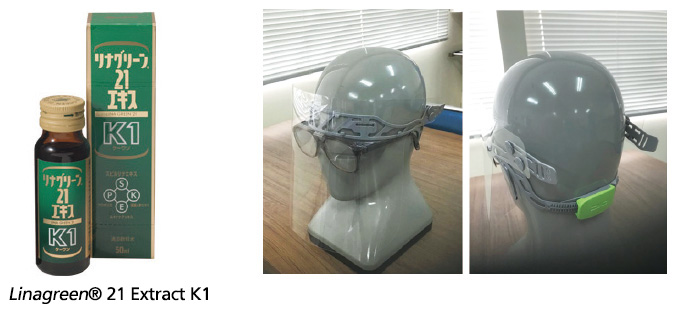
Capitalizing on Business Opportunities Yielded by Recycling Initiatives
In addition to manufacturing and selling a broad range of molded plastic products in line with its ultimate objective, which is to protect lives, Group company DIC Plastics, Inc., in Japan, is an active proponent of environment-friendly business practices, particularly material recycling*1. Among the company’s noteworthy achievements is its development of a system for sorting waste plastic generated during the manufacture of original products by type and color, which greatly assists with recovery. This has enabled the company to diversify its lineup of products made with recycled plastics, increasing the volume of such materials it uses and adding value to the products in which they are used.
DIC Plastics also promotes recycling by purchasing recycled plastics from reclaimers, which it uses in the manufacture of its mainstay plastic helmets and other products.
One of the most recent additions to DIC Plastics’ product portfolio is the IZANO professional helmet for disaster situations. In addition to offering superb safety, the IZANO helmet can be folded to approximately 60% of its full size. These features, plus the extensive range of colors available, earned IZANO an award in the 2014 Good Design Awards*2, sponsored by the Japan Institute of Design Promotion.
- Material recycling involves the recycling of material from an original application but in a different form.
- Operated by the Japan Institute of Design PromotColor Universal Design in interiors and signs in a sports clubion, the Good Design Awards is a commendation program that annually recognizes products that represent superb achievements in design.
Highlights of Social Contribution Activities
Color Universal Design in interiors and signs in a sports club
Based on the management vision: “Color & Comfort by Chemistry,” Ethe DIC Group takes initiatives in Color Universal Design (UD). DIC Color Design Inc. provided color supervision upon the redesigning of the “Sports Club Renaissance, Makuhari,” which is the original branch of RENAISSANCE INC. that runs sports clubs throughout Japan. DIC Color Design Inc. utilized the color investigation that was conducted in existing branches prior to the redesigning from the perspective of UD. You can see innovations in colors in the interior and signs, etc. that enable the Renaissance facility users to enjoy sports with a sense of security. Considerations for colors are given in a number of places, including steps in stairs and rails using colors that are
COMMENT
Facility development with the aim of achieving security and safety of users

The Makuhari branch is the first branch of Renaissance and is a facility that we have special feeling toward this branch. Upon the redesigning, we strived for a facility that can be a model case in all perspectives, such as contributions to society and environmental considerations, etc., in addition to enhancing equipment and items. Especially, the Makuhari branch is rooted in the community, and many elderly people also utilize our facility. Through this effort, we have learned that there were actually people who would have difficulties with the colors that we would otherwise have not paid attention to. In addition, we have truly learned the importance of not only producing a unified image in color design but also using color schemes that correctly communicate necessary information by considering the functionality of the facility and safety of users. We hope to widely spread this experience in the company and utilize it in the future facility development.
RENAISSANCE INC. Facility Development Department Ms. Itsuwa Hosaka
Spirulina: Promoting Harmony With Society
The DIC Group is the world’s largest supplier of Spirulina, a cyanobacteria rich in more than 50 nutrients, including vitamins, minerals and essential amino acids. In line with a support agreement concluded in 2009 with the Alliance Forum Foundation (AFF), a Japan-based NPO, the Group provides assistance to the Spirulina Project, an AFF initiative that seeks to alleviate hunger and improve nutrition in the Republic of Zambia.
In June 2012, with the purpose of contributing to the well-being of the people of Zambia, we implemented a project to assess the impact of Spirulina on human health. This project verifed a reduced incidence of malnutrition among children who regularly consumed Spirulina. Encouraged by these findings, the DIC Group and the AFF conducted production and technological feasibility studies in Zambia with the aim of facilitating local cultivation of Spirulina for local consumption, and in 2014 commenced pilot production. In fscal year 2015, the DIC Group and the AFF will again conduct tests to measure the effectiveness of Spirulina, expanding the scope of testing to several hundred individuals. DIC support it by the donation of bulk powdered Spirulina. Currently, the Group also provides production and technological support through assistance with selecting locations for cultivation and providing information on raw materials.
The DIC Group is also engaged in a variety of other initiatives designed to promote the nutritional value of Spirulina. In fscal year 2014, these included a nutritional education program for private elementary schools in Tokyo’s Itabashi Ward.
Highlights of Social Contribution Activities
Initiatives Toward Color Coordination that is Harmonious with Landscape
Development and Evaluation of New Tactile Paving Aimed at Low-vision People The DIC Group promotes the development of colors and color combinations that can be recognized equally by as many people as possible.
Tactile pavement that indicate safe walking paths are considered ideal to have a clear contrast with the road by using highly visible yellow color. However, urban landscape designers often feel the color too vivid that does not harmonize with the surrounding environment. Therefore, it is required to develop guide blocks that simultaneously fulfill safety and aesthetical requirements.
Associate Professor Kei Ito of the Institute of Molecular and Cellular Biosciences at the University of Tokyo has been attempting to use two different colors for guide blocks as a countermeasure to this issue. By using low intensity color for the base part and pale yellow for the protrusions, the new blocks would not violate the landscape while securing both visibility and sign property For the project, DIC Color Design proposed color schemes that simultaneously achieve functionality and harmony with surrounding environments and cooperated in color selections for the prototype samples. We have been repeating evaluation experiments by trial subjects and promoting the project for practical usage.
Career Education Activities
In recent years, the educational field is strongly required to participate in corporate career education activities. DIC focuses on career education in a wide scope, including accepting interns from colleges of technology in plants throughout Japan, accepting workplace experience, practical training, and tours from nearby schools in the Chiba Plant, Hokuriku Plant, Kashima Plant, Komaki Plant, and Saitama Plant, etc. providing lab lessons in municipal elementary schools in the Itabashi Ward and Matsudo by Tokyo plant and headquarters, providing educational support classes to Chiba Prefectural Sakura High School and Sakurahigashi High School close to the DIC Central Research Laboratory, and visits by Chairman Sugie throughout Japan to give classes as part of Japan Association of Corporate Executives activities, etc. Children learn the significance of working and the fact that their studies lead to social lives by learning various ways of living and a sense of values by communicating with many different adults. DIC will continue to provide career education opportunities to children who will lead the future.
COMMENT
Promoting career education that arouses intellectual curiosity and inquisitive minds

The DIC Central Research Laboratory has raised educational support in the CSR policy and has also been supporting “Sakura Academia,” which is a cultural class that started in 2011 in our school. In this class, students visit laboratories to hear lectures by leading researchers with the aim of not only arousing students’ intellectual curiosity and inquisitive minds but also encouraging them to strive to realize themselves and have career awareness. In 2013, our school was specified as a super science school (SSH) by the Ministry of Education, Culture, Sports, Science and Technology with the aim of developing human resources in the scientific technology field. Upon this, DIC dispatched an operational mentor as a representative of a local company. We are always deeply appreciative of DIC’s stance to proactively contribute to the local educational industry through the scientific technology field.
Chiba Prefectural Sakura High School Vice-Principal Mr. Kazuomi Koshiba
Proactively Supporting the Next Generation Development from Working Experience for Junior High School Students to Training Cooperation for Teachers
Each plant in the DIC Group holds opportunities that enable young people who will lead the next generation to experience working in order to acquire career or working views and proactively hosts internship students, etc. “Saitama Plant”(Ina City, Saitama)that manufactures UV paint, LC materials, and adhesive films, etc. cooperates with the “Social Experience Challenge”, which is planned by the board of education, and continually holds working experience opportunities for 7th and 8th grade students. In 2011, the plant held 4 opportunities and 12 junior high school students participated from the community. They commuted to the Saitama Plant for 3 days at a time and experienced light work, such as inspections of products, packaging, etc. They presented what they learned through work and exchanges with employees at school.
These efforts are also promoted in Chiba Plant and Komaki Plant (Aichi)are highly regarded by the local communities.
COMMENT
Backup is Provided through Cooperation of Each Department with the Focus on Safety
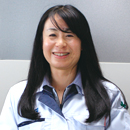
Saitama Plant has been hosting working experience opportunities since approximately 10 years ago. First, we communicate safety cautions to children, and each department decides the work contents in cooperation with each other. Seeing papers with honest opinions, such as “I’ve learned the difficulty of the society” and “I’ve experienced the importance of people’s considerations as well as organization”, etc. after the experience and hearing voices of different departments, such as “Thanks to them, we’ve made a good progress in work”, etc., make us happy. In 2011, teachers also cooperated with the training to learn local industries and accepted plant tours. I think it is very beneficial for others to learn the technologies and manufacturing of DIC through such opportunities.
Saitama Plant General Affairs Group Chiharu Nakanishi
Support for Persons with Intellectual Handicaps
“Huiling” is an NGO that was established in 1990 by a Chinese national and supports persons with intellectual handicaps. It promotes its activities in 8 locations in China. DIC Co., Ltd. (Guangzhou)observed various activities of Huiling Guangzhou, deepened the understanding, and supported the philosophy. The company has appealed for donations from both employees and the company.
In addition, 86 employees/family members participated in the charity jogging, which was held in the “Oriental Resort Guangzhou” in Báiyún area, Guangzhou, and held social exchanges with persons with intellectual handicaps in May,2011.
Support for Disaster-Hit Areas
DIC currently donates funds to assist reconstruction in areas devastated by the April 2016 Kumamoto Earthquake though participation in the IPPO IPPO NIPPON project, an initiative organized for this purpose Earthquake by Keizai Doyukai (Japan Association of Corporate Executives).
Mangrove Plantation Project
DIC(Malaysia)Sdn. Bhd. approved of the mangrove plantation project in the Telok Gong, Pelabuhan Klang, Selangor, Malaysia held by the Red Crescent Selangor on May 8, 2011, and donated money to fund the activity and joined the project.
The purpose of the project is to reduce environmental destruction by showing the way how to solve environmental problems to the local community as well as the participants through the activity of mangrove plantation. Ten employees of DIC took part as volunteers on the day and planted mangrove seedlings under the instruction of experts.
Initiatives Aimed at Areas around Our Plants
As part of its Responsible Care activities, the Japan Chemical Industry Association's RC Committee has organized town hall meetings across the country to strengthen communication with people locally.
In February 2011, The DIC Komaki plant organized the 5th Responsible Care Aichi Regional Town Hall Meeting at the Komaki Kinro Center, where it presented its Responsible Care initiatives to local citizens. Its presentations covered mainly safety (passing on techniques through K-SHOW)*2 and eco-friendly products, also providing reports on matters such as energy conservation, industrial waste reduction, and local support activities(Oyamagawa cleanup). The DIC Komaki plant focused especially on discussion of its production and development of environmentally conscious products such as lightweight PPS for cars, low-VOC-emission printing ink, and decorative sheets for de-plating products**1. The plant also talked about the various problems it has related to the environment. After the meeting, the plant made time to answer questions from local citizens and strengthen mutual understanding.
- Passing on technique through K-SHOW: passing on techniques through training, using video to explain.
Regional Clean-Up Activities and Others
To help preserve and beautify the regional environment, the DIC Group has been conducting clean-up activities in places such as neighboring roads in various regions. At the plant in Konan City, Shiga Prefecture, employees take part in clean-up day activities such as "Lake Biwa Day" and "Environment Beautification Day" organized by Shiga Prefecture every year. The Komaki Plant in Aichi Prefecture positively engages in volunteer activities such as "Oyama River Clean-up Activities." Moreover, part of the sports facilities in our plants are open to local citizens, and festivals are held by inviting local citizens for realizing a better relationship with local communities.

